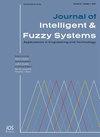混合ResGRU:利用异常图像进行脑肿瘤分类的有效方法
IF 1
4区 计算机科学
Q3 COMPUTER SCIENCE, ARTIFICIAL INTELLIGENCE
引用次数: 0
摘要
脑肿瘤呈不规则形状生长,并出现在导致癌症的组织深处。人脑肿瘤的识别和分类具有较高的潜伏期,也是医学专家必须完成的一项任务。为了在脑肿瘤检测中获得较高的准确性,通常利用自动诊断的辅助来提高诊断能力。虽然研究提高了脑肿瘤的检测性能,但由于脑肿瘤的类型、对比度、图像形态等因素的多变性,对脑肿瘤进行分割是一项极具挑战性的工作。为了应对这些挑战,本文引入了一种基于分割和机器学习的分类方法。最初,从基准数据源收集所需的图像。输入图像经过预处理阶段,通过“对比度有限自适应直方图均衡化(CLAHE)和滤波方法”完成。此外,将预处理后的图像作为“残差网络(ResNet)”和“门控循环单元(GRU)”两个分类器模型的输入,其中模型提供正常和异常图像的结果。在第二部分中,获取的异常图像作为分割步骤的输入。在分割中,需要通过纹理和空间特征提取相关特征。对得到的特征进行优化,通过自适应郊狼优化算法(ACOA)获得最优特征。然后,将提取的特征输入到“支持向量机(SVM)、人工神经网络(ANN)和随机森林(RF)”等机器学习模型中,对分割后的图像进行渲染。最后,结合ResNet和GRU开发了混合分类hybrid ResGRUis,其中超参数使用开发的ACOA进行优化调整,从而用于分类属于良性阶段或恶性阶段的异常图像。对实验结果进行了评价,并用各种指标对其性能进行了分析。因此,所提出的分类模型保证了有效的分割和分类性能。本文章由计算机程序翻译,如有差异,请以英文原文为准。
Hybrid ResGRU: Effective brain tumour classification approach using of abnormal images
Brain tumor is observed to be grown in irregular shape and presented deep inside the tissues that led to cancer. Human brain tumor identification and categorization are performed with high latency, but also an essential task for the medical experts. The assistance through the automated diagnosis is generally utilized for the advancement in the diagnosis ability in order to get superior accuracy in brain tumor detection. Although the researches are enhancing the brain tumor detection performance, the highly challenging is to segment the brain tumor since it has variability concerning the tumor type, contrast, image modality and also in other factors. To meet up all the challenges, a novel classification method is introduced using segmentation and machine learning approaches. Initially, the required images are collected from benchmark data sources. The input images are undergone for pre-processing stage, where it is done via “Contrast Limited Adaptive Histogram Equalization (CLAHE) and filtering methods”. Further, the pre-processed imagesare given as input to two classifier models as “Residual Network (ResNet) and Gated Recurrent Unit (GRU)”, in which the model provide the result as normal and abnormal images. In the second part, obtained abnormal image acts an input for segmentation step. In segmentation, it is needed to extract the relevant features by texture and spatial features. The resultant features are subjected for optimizing, where the optimal features are acquired through Adaptive Coyote Optimization Algorithm (ACOA). Then, the extracted features are fed into machine learning model like “Support Vector Machine (SVM), Artificial Neural Network (ANN), and Random Forest (RF)” to render the segmented image. Finally, the hybrid classification named Hybrid ResGRUis developed by integrating the ResNet and GRU, where the hyper parameters are tuned optimally using developed ACOA, thus it is used for classifying the abnormal image that belongs to benign stage or malignant stage. The experimental results are evaluated, and its performance is analyzed by various metrics. Hence, the proposed classification model ensures effective segmentation and classification performance.
求助全文
通过发布文献求助,成功后即可免费获取论文全文。
去求助
来源期刊

Journal of Intelligent & Fuzzy Systems
工程技术-计算机:人工智能
CiteScore
3.40
自引率
10.00%
发文量
965
审稿时长
5.1 months
期刊介绍:
The purpose of the Journal of Intelligent & Fuzzy Systems: Applications in Engineering and Technology is to foster advancements of knowledge and help disseminate results concerning recent applications and case studies in the areas of fuzzy logic, intelligent systems, and web-based applications among working professionals and professionals in education and research, covering a broad cross-section of technical disciplines.
 求助内容:
求助内容: 应助结果提醒方式:
应助结果提醒方式:


